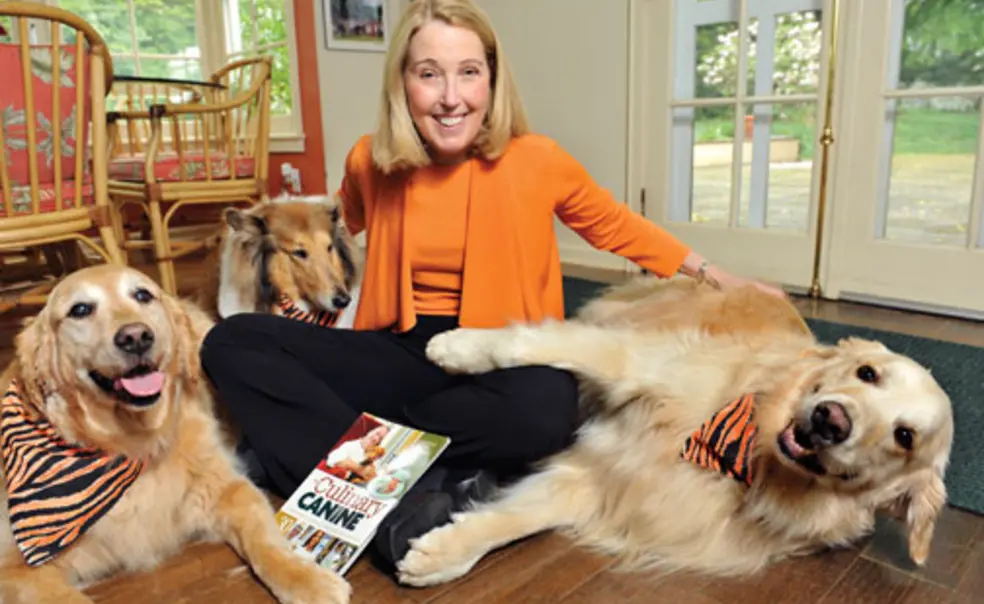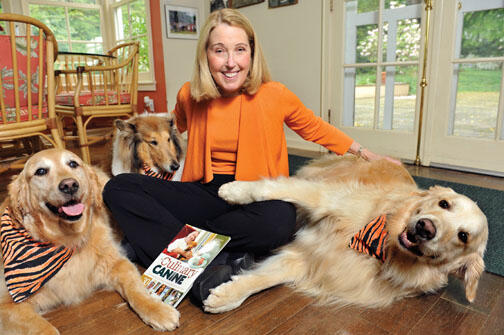Editor’s note: PAW senior writer Mark F. Bernstein ’83 spent a day in the kitchen with the author of The Culinary Canine, Kathryn Levy Feldman ’78.
When I called Kathryn “Kit” Levy Feldman ’78 to plan our cooking demonstration, the first thing we discussed was whether I would bring Butter — the dog, that is, not the Higher-Priced Spread.
Butter is my rambunctious 7-year-old Labrador retriever. Feldman is the co-author of The Culinary Canine (Bowtie Press), a gourmet cookbook for dogs. She approached chefs from around the country, asking them to share recipes they prepare at home for their pets. Calling it “dog food” doesn’t really do these dishes justice; they all use fresh ingredients, and most can be enjoyed by dogs and owners alike. My PAW assignment was to bring Butter to sample a few of those creations in Feldman’s kitchen on Philadelphia’s Main Line. She and I reached an understanding. She would provide butter. I would provide Butter.
Actually, Eileen Watkin provided butter. Watkin is the executive chef at the Inn at Penn, a block from the University of Pennsylvania campus, and she was the one whose recipes we would be sampling. She whipped up salmon rice balls — excuse me, brown rice arancini with sweet potato, spinach, Parmesan cheese, and ground salmon — and also brought mini chicken meatloafs. Watkin described our repast as “Italian comfort food.”
Italian comfort food is best enjoyed in a group, so Feldman included her own three dogs — two golden retrievers named Phoebe and Sam, and Amos, a collie. Would Butter like Italian comfort food? I was not worried. The culinary bar here, I have to tell you, is very low. Butter happily eats the two cups of kibble I feed her each day, but she will vacuum up a greasy napkin with the same enthusiasm. Hers is not a sophisticated palate.
Feldman credits the idea for The Culinary Canine to Sabina Louise Pierce, her co-author and the book’s photographer. The two were having lunch in 2007 shortly after a national pet-food recall was announced because it had been discovered that some foreign-made brands were laced with melamine. The restaurant where they were eating welcomed dogs in its outdoor seating area and provided them with water. Wouldn’t it be a good idea, Pierce suggested, if restaurants offered food for dogs as well?
For most of human history, domesticated dogs ate scraps from their masters’ plates. It wasn’t until 1860 that the first processed dog food was introduced, although Feldman has found dog-food recipes dating back to the late 18th century. The 2007 recall, the largest in pet-food history, made many people pay more attention to what was in their best friends’ supper dishes, accelerating a trend toward pampering our pets that was already well under way. “We’ve really come full circle,” Feldman says.
Matthew Levin, who is now a co-owner of the Square Peg restaurant but in 2007 was the executive chef at Lacroix (both are in Philadelphia), was so unsettled by the recall that he began to prepare all of his dogs’ meals. He was the first chef Feldman recruited for the book, and he helped connect her with others, including Cosme Aguilar, the executive chef and part owner, with Winston Kulok ’57, of Bar Henry in New York.
In each chapter, a chef discusses his or her dog and then offers a favorite recipe. Dana Tommasino and Margie Conrad, co-owners of San Francisco’s Woodward’s Garden, for example, contributed a recipe for goat shanks with fennel, coriander, and honey. Tanya Nunes, owner of Chef Tanya Inc. in Daly City, Calif., included “Kosher for Passover Dog Food” consisting of ground meat, quinoa, flaxseed meal, and carrots that will be sure to make your setter’s seder. (“Why is this meal different from all other meals?” “Well, for starters, it’s being served in a plastic bowl that says ‘Fluffy’ on the side.”)
Since the book’s publication last fall, Feldman has finished a five-city promotional tour, and a few of her chefs have touted their creations on The Martha Stewart Show, Fox & Friends, and other stops around the cable dial. Comedian Joan Rivers, a noted dog lover, has hailed The Culinary Canine as “gorgeous and informative.” A freelance writer, Feldman, who has a certificate in animal studies from Penn, is working on a sequel. How about a collection of gourmet recipes for cats? Cats, she acknowledges with understatement, “are difficult.” Not only are they notoriously finicky, they are strictly carnivores and their diets are much narrower, making it harder for chefs to experiment with new ingredients.
“Finicky,” however, is not a word usually associated with dogs. Did Feldman find anything during her research, I asked, that her dogs wouldn’t eat?
“Are you kidding?” she replied. Apparently there are no four-legged Gael Greenes in her house, either.
Feldman and her publisher did, however, work with veterinarians to make sure that all the recipes were safe and nutritionally balanced. Some human foods are toxic to dogs — chocolate, of course, but also avocados, onions, garlic, grapes, raisins, and macadamia nuts, according to the ASPCA website. Although some chefs, such as Georges Perrier, who recently stepped aside as owner of Philadelphia’s legendary Le Bec-Fin, claim to cook everything their dogs eat, it probably is too much to expect that level of care every day. Recipes in The Culinary Canine are meant to be “special-occasion” meals, the doggy equivalent of an anniversary splurge at Le Cirque.
It is up to each pet owner to decide how far to take these doggy delights — after all, the ingredients aren’t cheap and the preparation can be time-consuming. Does Fido really need sustainable vegan options at mealtime, or is that just an indulgence to make his owner feel better? On that, Feldman declines to weigh in. But she does point out that dogs are members of the family, and so it is reasonable — and perhaps even economical — to share a meal rather than let leftovers go to waste. At least you know where everything came from, not that your dog is likely to care.
In the book’s introduction, veterinarian Patty Khuly disputes the notion that a dog really can be happy or healthy eating the same thing day after day. Rejecting what she calls the “one-bag-for-life” dietary philosophy, she advocates instead for a “more enlightened canine lifestyle.” Dogs, Khuly writes, being “co-recipients of the classification ‘omnivore’ ... deserve to share in the bounty that graces human tables.” Be that as it may, the “bounty” that Butter gets from my table usually consists of steak gristle and pizza crusts, yet she thinks I am a god.
Therein, I think, lies a lesson. As the old saying goes, a good pig eats everything, meaning that people should consume new experiences with the same gusto that a pig exhibits in devouring whatever is set before it. Dogs take a similar approach to life. There is something endearing, even inspiring, in their tail-wagging gratitude and willingness to sample new things. Aren’t those qualities we all should try to cultivate?
When Watkin took her treats out of the oven, we gathered the dogs for the ultimate taste test, which lasted about five and a half seconds. Our dogs went through that food like a hot knife through ... well, you know. All four pronounced Watkin’s crudités finger-licking — OK, floor-licking — good. There even were some extras, which I took home and reheated the next day. Butter loved them just as much the second time around. And I have to admit, the chicken meatloaf was delicious.
I’m sure the salmon rice balls were, too. I didn’t try them. I’m not really crazy about salmon.













No responses yet